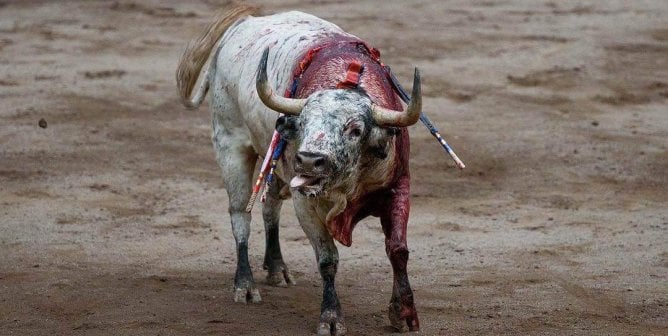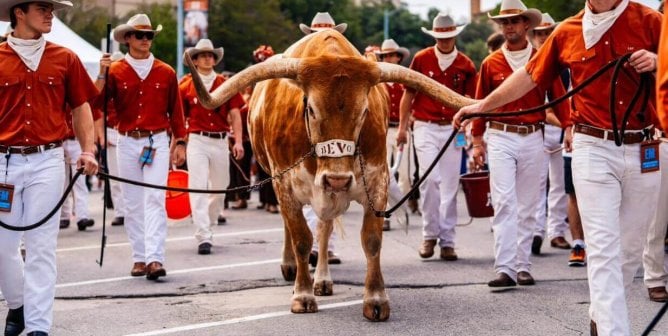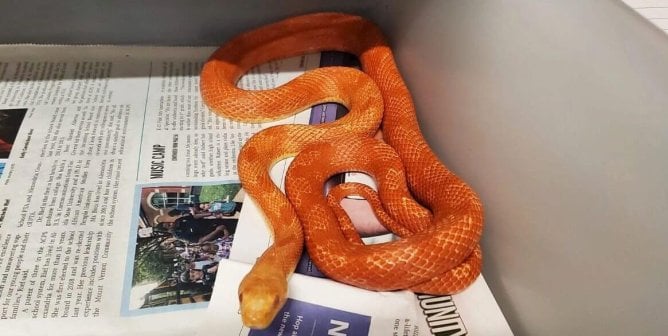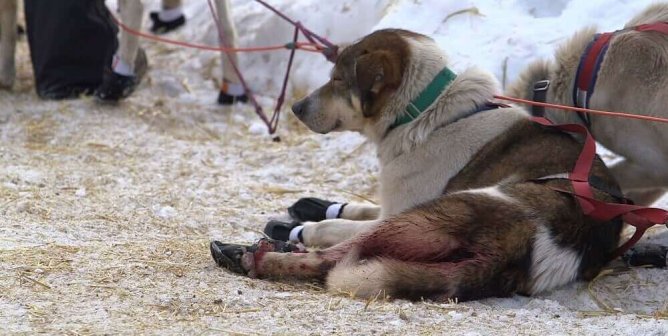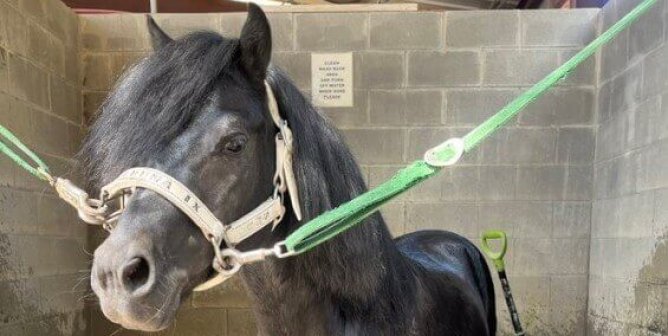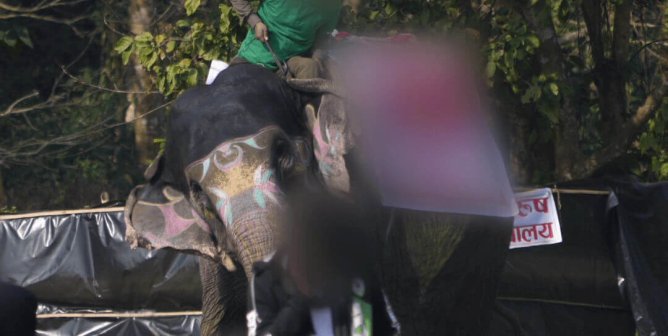Rodeo: Cruelty for a Buck
Rodeos are promoted as rough-and-tough exercises of human skill and courage in conquering the fierce, untamed beasts of the Wild West. But in reality, rodeos are nothing more than manipulative displays of human domination over animals, thinly disguised as entertainment. What began in the 1800s as a contest of skill among cowboys has become a show motivated by greed and big profits.1
The Stunts
Standard rodeo events include calf roping, steer wrestling, bareback horse and bull riding, saddle bronc riding, steer roping, and barrel racing.2 The animals used in rodeos are captive performers. Most are relatively tame but understandably distrustful of humans because of the harsh treatment that they have received. Many of these animals are not aggressive by nature; they are physically provoked into displaying “wild” behavior in order to make the cowboys look brave.
Tools of Torment
Electric prods, spurs, and bucking straps are used to irritate and enrage animals in rodeos. The flank, or “bucking,” strap or rope is tightly cinched around the animals’ abdomens, which causes them to “buck vigorously to try to rid themselves of the torment.”3 “Bucking horses often develop back problems from the repeated poundings they take from the cowboys,” Dr. Cordell Leif told the Denver Post. “There’s also a real leg injury where a tendon breaks down. Horses don’t normally jump up and down.”4
When the flank strap is paired with spurring, it causes the animals to buck even more violently, often resulting in serious injuries.5 Former animal control officers have found burrs and other irritants placed under the flank strap.6 In addition, the flank strap can cause open wounds and burns when the hair is rubbed off and the skin chafes.7
Cows and horses are often prodded with an electrical “hotshot” while in the chute to rile them, causing intense pain to the animals. Peggy Larson—a veterinarian who in her youth was a bareback bronc rider—said, “Bovines are more susceptible to electrical current than other animals. Perhaps because they have a huge ‘electrolyte’ vat, the rumen [one of their stomachs].”8
Injuries and Deaths
Although rodeo cowboys voluntarily risk injury by participating in events, the animals they use have no such choice. Because speed is a factor in many rodeo events, the risk of accidents is high.
By the end of the annual Calgary Stampede in Alberta, Canada, several animals are usually dead. In 2005, horses destined for the event stampeded in fear as they were being herded across a bridge; some jumped and others were pushed into the river. Nine horses died.9 In 2009, a steer who suffered a spinal cord injury during a roping event as well as three horses died.10 Six horses died in the 2010 Stampede, two from heart attacks, one from a broken back, and another from a shoulder injury so severe that the attending veterinarian ordered the animal to be euthanized.11,12
At the 2010 Colorado rodeo in Denver, 11 animals were injured—two fatally—during an event in which a horseback rider grabs a cow by the tail and slams the animal to the ground. Animal cruelty charges were filed against the organizers of the rodeo after sheriff’s investigators reported that some animals’ tails had ripped off and that animals’ bones had been broken.13
Calves who are roped while running routinely have their necks snapped back by the lasso, often resulting in neck injuries.14 Even Bud Kerby, owner and operator of Bar T Rodeos Inc., agrees that calf roping is inhumane. He told the St. George Spectrum that he “wouldn’t mind seeing calf roping phased out.”15 During Rodeo Houston, a bull with a broken neck suffered for a full 15 minutes before he was euthanized following a steer-wrestling competition, which was described by a local newspaper as an event in which “cowboys violently twist the heads of steers weighing about 500 pounds to bring them to the ground.”16
Rodeo association rules are not effective in preventing injuries and are not strictly enforced, and penalties are not severe enough to deter abuse. For example, one rule states, “Any member guilty of mistreatment of livestock anywhere on the rodeo grounds shall be fined $250 for the first offense with that fine progressively doubling with each offense thereafter.”17 But fines are small compared to the large purses that are at stake. Rules also allow the animals to be confined or transported in vehicles for up to 24 hours without being properly fed, watered, or unloaded.
The End of the Trail
The late Dr. C.G. Haber, a veterinarian who spent 30 years as a federal meat inspector, worked in slaughterhouses and saw many animals discarded from rodeos and sold for slaughter. He described the animals as being so extensively bruised that the only areas in which their skin was attached to their flesh were the head, neck, legs, and belly. He described seeing animals “with 6–8 ribs broken from the spine, and at times puncturing the lungs.” Haber saw animals with “as much as 2–3 gallons of free blood accumulated under the detached skin.”18 These injuries resulted when animals were thrown in calf-roping events and when people jumped on them from the backs of horses during steer wrestling.
Spurn the Spurs
If a rodeo comes to your town, protest to local authorities, write letters to sponsors, distribute leaflets at the gate, or hold a demonstration. Contact PETA for posters and fliers.
Check state and local laws to find out what types of activities involving animals are and are not legal in your area. For example, after a spectator videotaped a bull breaking his leg during a rodeo event, Pittsburgh passed a law prohibiting bucking straps, electric prods, and sharpened or fixed spurs. Because most rodeos use flank straps prohibited by the Pittsburgh law, the measure effectively banned rodeos altogether.1 Another successful means of banning rodeos is to institute a state or local ban on calf roping, the event in which cruelty is most easily documented. Because many rodeo circuits require calf roping, eliminating it can result in the elimination of all rodeo shows.
References
1Ronda Quaid, “A Tip of the Hat to the Vaqueros,” Coastline 1996.
2Professional Rodeo Cowboys Association, “PRCA Event Descriptions,” 2010.
3Hattie Klotz, “Bucking Bronco Dies in Corel Center Rodeo,” The Ottawa Citizen 9 Aug. 1999.
4Steve Lipsher, “Veterinarian Calls Rodeos Brutal to Stock,” Denver Post 20 Jan. 1991.
5Peggy Larson, e-mail to PETA, 15 Nov. 2001.
6Ingrid E. Newkirk, former animal control officer, eyewitness account.
7Chris Heidenrich, “Animal-Rights Group Protests Rodeo,” Daily Herald 17 July 1998.
8Larson.
9CBC News Online, “Deadly Accidents at the Calgary Stampede,” 4 July 2005.
10Petti Fong, “Stampede Horse Deaths Spark Debate,” Toronto Star 14 July 2010.
11Stephanie Dearing, “Animal Deaths, Human Injuries Cast Shadow Over Calvary Stampede,” Digital Journal 17 July 2010.
12Fong.
13John Romero, “Rodeo to Resume in Jefferson Co. Despite Animal Cruelty Case,” KDVR, 3 Aug. 2010.
14Lipsher.
15Patrice St. Germain, “PETA: Rodeo Cruel to Animals; Rodeo Fans Say Animals Treated Well,” St. George Spectrum 15 Sep. 2001.
16“Steer Suffers Broken Neck During Top Wrestling Run,” Houston Chronicle 17 Mar. 2006.
17Professional Rodeo Cowboys Association, “PRCA Rules Governing the Care and Treatment of Livestock at PRCA Sanctioned Rodeos,” Palm Springs WestFest, accessed 2 Dec. 2010.
18The Humane Society of the United States, interview with C.G. Haber, 1979.
19Timothy McNulty, “City Council Prodded to Ease Rules and Bring Back Rodeos,” Pittsburgh Post-Gazette 18 June 2002.

